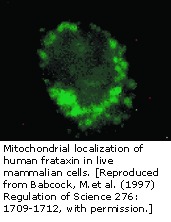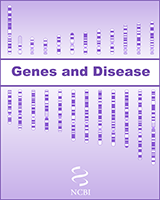NCBI Bookshelf. A service of the National Library of Medicine, National Institutes of Health.
National Center for Biotechnology Information (US). Genes and Disease [Internet]. Bethesda (MD): National Center for Biotechnology Information (US); 1998-.

Friedreich's ataxia (FRDA) is a rare inherited disease characterized by the progressive loss of voluntary muscular coordination (ataxia) and heart enlargement. It is named after the German doctor, Nikolaus Friedreich, who first described the disease in 1863. FRDA is generally diagnosed in childhood and affects both males and females.
FRDA is an autosomal recessive disease caused by a mutation of a gene called frataxin, which is located on chromosome 9. This mutation means that there are many extra copies of a DNA segment, the trinucleotide GAA. A normal individual has 8 to 30 copies of this trinucleotide, while FRDA patients have as many as 1000. The larger the number of GAA copies, the earlier the onset of the disease and the quicker the decline of the patient.
Although we know that frataxin is found in the mitochondria of humans, we do not yet know its function. However, there is a very similar protein in yeast, YFH1, which we know more about. YFH1 is involved in controlling iron levels and respiratory function. Since frataxin and YFH1 are so similar, studying YFH1 may help us understand the role of frataxin in FRDA.
Related diseases
- Genome view see gene locations
- Entrez Gene collection of gene-related information
- BLink related sequences in different organisms
- Research articles online full text
- Books online books section
- OMIM catalog of human genes and disorders
- GeneReviews a medical genetics resource
- National Ataxia Foundation supporting research into Hereditary Ataxia
- Friedreich's ataxia - Genes and DiseaseFriedreich's ataxia - Genes and Disease
Your browsing activity is empty.
Activity recording is turned off.
See more...
